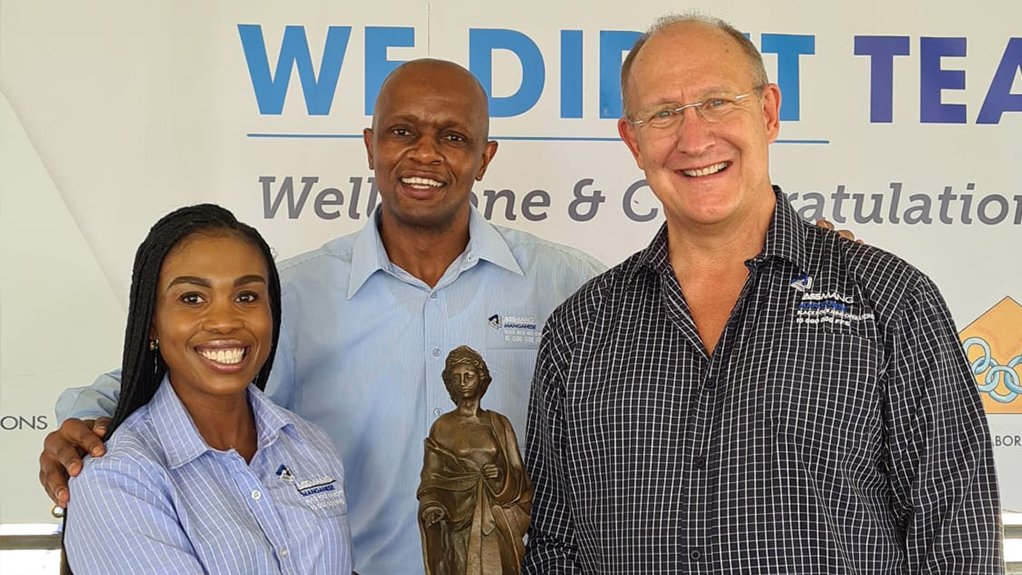JOHANNESBURG (miningweekly.com) – Assmang’s Black Rock mine, near Hotazel in the Northern Cape, has achieved ten-million fatality-free shifts, a record that has taken 13 years to achieve.
Assmang is a 50:50 partnership between Patrice Motsepe’s African Rainbow Minerals and Desmond Sacco’s Assore.
The last fatality at the underground manganese mine, which employs 6 000 people, made up of 4 400 permanent employees and 1 600 contractors, was on April 23, 2009.
Adding to the milestone was that it was achieved during the ramping up of the operation’s run-of-mine ore production from 3.6-million tons in 2011, to 5.1-million tons forecast for 2022.
At the function attended by 3 500 employees and contractors, Black Rock mine senior GM Wilhemina Ngcobo cautioned against complacency and reminded that safety can be compared with sweeping water uphill – it requires constant work and focus.
Among those who added messages were National Union of Mineworkers’ Rachlel Phete, Solidarity’s Joe Bruwer and Inspector of Mines’ Tumelo Mateta.
Assmang has executed a multibillion-rand modernisation and refurbishment brownfield project over a ten-year period, and major developments that took place during the ten-million fatality-free shifts period, included:
- the Nchwaning 2 vertical shaft being stripped, upgraded and re-equipped, and a new rock winder and personnel winder being installed;
- the Nchwaning surface processing plant being refurbished;
- a new stockyard, stacker-reclaimer and train-loading facility, as well as a new rail balloon, being built;
- the building of a new rail link to enhance the operational efficiency of Transnet being built;
- the excavation and equipping of an additional 17 underground storage silos, measuring 25 m high and 7 m in diameter;
- the carrying out of extensive underground excavations, requiring life-of mine support and additional grouting to allow the contractors and mine staff to continue to work in a safe environment;
- the installation of extensive underground infrastructure, conveyor belts, tips, rock breakers, fully compliant with all fire protection to accommodate the increase in production volumes;
- the sinking and equipping of a new ventilation shaft and equipped at Gloria with zero lost-time injuries;
- the installation of a new underground crushing and screening plant at the Gloria mine;
- the stripping and reinstallation of an old conveyor belt system in the Gloria decline shaft as well as new surface ore handling systems; and
- the decommissioning of the old Gloria processing plant and the building and commissioning of a new one.
“These tasks were executed in challenging circumstances,” African Rainbow Minerals Ferrous Division CE Andre Joubert emphasised in a release to Mining Weekly.
The model used for the safe and timeous execution of these projects was to appoint a dedicated owner’s team and to involve specialist engineering procurement, construction and management (EPCM) consultants.
The main EPCM consultants for these projects were DRA, Worley Parsons and Irritron. Other companies contributing to the success of the projects include Murray & Roberts, Advent One, Burger and Company, TDS Construction, Olivier Construction, Group 5 Projects, Tau Dipolka Mining and BCQS Quantity Surveyors.
The challenges centred on the logistics associated with an underground brownfield project of this magnitude, poor ground conditions which required additional primary and secondary support before construction access could be granted, and abnormally large underground excavations that had to be created.
The project required the manufacture, fabrication and installation of close to 11 000 t of steel and the laying of almost 350 km of electrical cable.
“It was a great partnership,” added Joubert.
EMAIL THIS ARTICLE SAVE THIS ARTICLE ARTICLE ENQUIRY
To subscribe email subscriptions@creamermedia.co.za or click here
To advertise email advertising@creamermedia.co.za or click here











